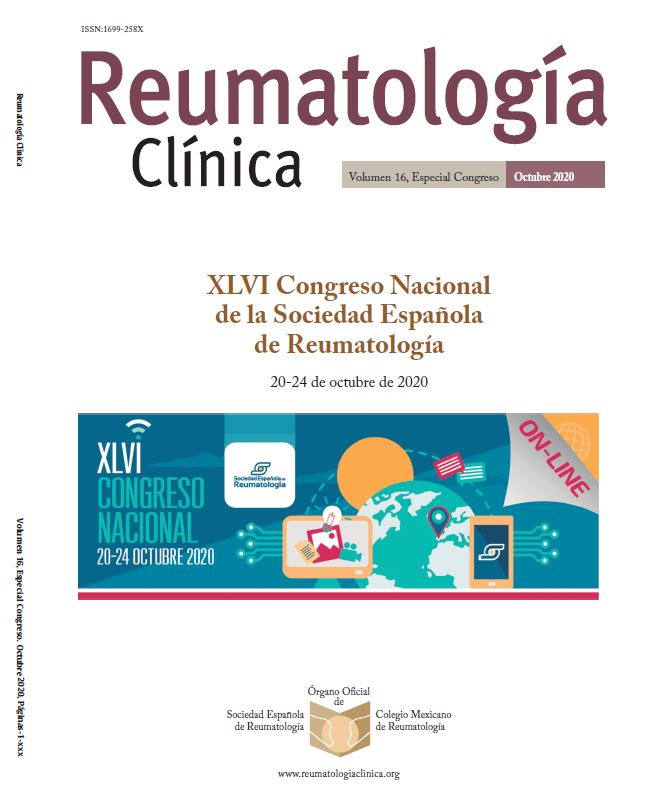CO32 - Clinical Impact of Musculoskeletal Ultrasound on Rheumatoid Arthritis in Routine Clinical Practice
1Hospital General Universitario Gregorio Marañón. Madrid. 2Complutense University of Madrid.
Introduction and objectives: Musculoskeletal ultrasound (MSUS) is a useful tool to assess disease activity in rheumatoid arthritis (RA) patients. However, it has not yet been established if its use would change treatment decisions within a treat to target strategy or whether it would lead to better outcomes in RA patients. Our aim was to determine the impact of MSUS in the clinical management of RA patients and investigate factors associated with subsequent clinical actions by the referring rheumatologist.
Methods: A prospective analysis of RA patients seen at an MSUS clinic over a 6-month period was undertaken. Pre- and post-US follow-up data (± 3 months) were analyzed. Baseline assessment included clinical features, physical examination and laboratory tests. All MSUS examinations were performed according to EULAR guidelines and using an Esaote MyLab 8 (Esaote, Genoa) with a high frequency (8-15 MHz) transducer. Patients were stratified in groups based on the clinical impact of the MSUS visit: 1) No clinical impact and 2) US findings leading to subsequent clinical action by the referring rheumatologist (including changes in dosages of current rheumatologic treatments, addition/substraction of medications or interventional procedures based on the MSUS results). First, differences between groups were tested using chi-squared and Student-t tests in the univariate analysis. Second, multivariate logistic regression models were employed to investigate factors associated to a change in clinical management.
Results: A total of 61 RA patients were included for analysis. Mean age was 61.9 ± 11.4 years and 51 (83.6%) were female. Disease activity assessment was the most frequent referral reason (43; 70.5%). Overall, MSUS led to a subsequent therapeutic action by the referring rheumatologist in 39 (63.9%) patients, and to a change in the underlying diagnosis and/or in the clinical impression of the chief complaint that generated the referral in 7 (11.5%) patients. Baseline characteristics between both groups are compared in Table 1. In the univariate analysis, the detection of Power Doppler (PD) synovitis/tenosynovitis and 28 swollen joint count were significantly associated with a subsequent clinical action. In the multivariate analysis only PD synovitis/tenosynovitis (OR = 3.28; 95%CI 1.06-10.27) remained significantly associated with a change in clinical management (Table 2).
|
Table 1. Baseline characteristics of RA patients |
||||||
|
Total |
Change in clinical management |
No change in clinical management |
p |
|||
|
n = 61 |
||||||
|
n = 39 (63.9%) |
n = 22 (36.1%) |
|||||
|
Age |
61.9 ± 11.4 |
61.5 ± 12.5 |
62.6 ± 9.2 |
0.7 |
||
|
Sex |
Female |
51 (83.6%) |
35 (89.7%) |
16 (72.7%) |
0,09 |
|
|
Smoking |
Non smoker |
33 (54.1%) |
17 (43.6%) |
16 (72.7%) |
0,08 |
|
|
Smoker |
13 (21.3%) |
11 (28.2%) |
2 (9.1%) |
|||
|
Former smoker |
15 (24.6%) |
11 (28.2%) |
13 (21.3%) |
|||
|
Radiographic erosions |
29 (48.3%) |
22 (57.9%) |
7 (31.8%) |
0.05 |
||
|
28 Tender Joint Count |
2.3 ± 3.4 |
2.7 ± 3.9 |
1.6 ± 2.4 |
0.2 |
||
|
28 Swollen Joint Count |
2 ± 3 |
2.6 ± 3.5 |
1.1 ± 1.6 |
< 0.05 |
||
|
ESR (mm/h) |
28.1 ± 20.6 |
26.1 ± 15.5 |
31.7 ± 27.4 |
0.4 |
||
|
CRP (g/L) |
1 ± 1.5 |
1 ± 1.4 |
0.9 ± 1.7 |
0.7 |
||
|
RF (IU/mL) |
175.8 ± 452.8 |
139.9 ± 249.5 |
243.9 ± 697.4 |
0.4 |
||
|
ACPA (IU/mL) |
775.6 ± 998.6 |
619.4 ± 797.1 |
1079.9 ± 1.275.9 |
0.2 |
||
|
US PD synovitis/tenosynovitis |
37 (60.7%) |
28 (71.8%) |
9 (40.9%) |
< 0.05 |
||
|
Table 2. Independent factors associated with a change in clinical management based on logistic regression model |
||||
|
p |
Odds ratio |
95%CI |
||
|
Lower |
Upper |
|||
|
28 Tender Joint Count |
0.13 |
1.24 |
0.94 |
1.64 |
|
US PD synovitis/tenosynovitis |
0.04 |
3.28 |
1.06 |
10.17 |
Conclusions: The most common indication of MSUS examination in RA patients was disease activity assessment. MSUS findings led frequent changes in therapeutic management and even to a change in the diagnosis in some of cases. The presence of PD synovitis/tenosynovitis was significantly associated to a change in the therapeutic management. These data highlight the impact of MSUS inflammatory findings in RA patients in daily clinical practice.







